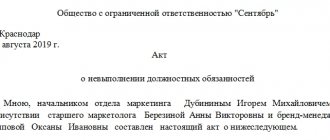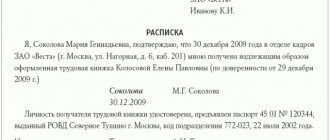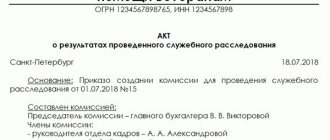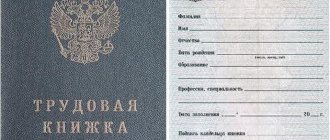The legislative framework
The norms of the Labor Code of the Russian Federation establish the possibility of applying a number of punishments to an employee for failure to perform labor functions at the proper level. Responsibility is established as:
- comments;
- reprimand;
- dismissals for certain reasons.
An employer, when imposing a penalty for committing an offense, must take into account both the gravity of the offense and the circumstances under which the event occurred. The regulation of labor regulations at the enterprise includes the following documents:
- labor agreement with the employee;
- job description;
- technical regulations;
- rules governing the internal labor regulations of the company.
The listed documents contain basic positions that help, if necessary, establish the fact and hold the employee accountable. The more detailed and competent the paperwork is, the easier it is to follow the procedures associated with the foreclosure procedure.
Act on violation of labor discipline
Employees are required to obey the rules of conduct established by the employer, determined in accordance with the Labor Code of the Russian Federation, other federal laws, collective agreements, agreements, local regulations, and employment contracts. In other words, they are obliged to observe labor discipline (Part 2 of Article 21, Part 1 of Article 189 of the Labor Code of the Russian Federation).
The employer rewards employees who conscientiously perform their job duties for observing labor discipline. For these purposes, the employer can, for example, express gratitude to the employee, give a bonus, award a valuable gift, a certificate of honor, or nominate him for the title of best in the profession (Article 191 of the Labor Code of the Russian Federation).
But for committing a disciplinary offense (i.e., failure or improper performance by an employee, through his fault, of the labor duties assigned to him), the employer has the right to apply a disciplinary sanction to the employee in the form of a reprimand, reprimand or even dismissal on appropriate grounds (Part 1 of Article 192 Labor Code of the Russian Federation). Examples of violations of labor discipline by an employee are the absence of an employee from the workplace without good reason, refusal or evasion without good reason from a mandatory medical examination (clause 35 of the Resolution of the Plenum of the Supreme Court of March 17, 2004 No. 2).
The fact that an employee has violated labor discipline must be confirmed by an appropriate document. For example, a memorandum or act. In our consultation, we will tell you how to draw up an act of violation of labor discipline by an employee and provide a sample of filling out the relevant document.
We draw up an act of violation of labor discipline
An act confirming the employee’s violation of labor discipline is drawn up by the commission in any form. For an act of violation of labor discipline, a sample can be downloaded from the link below.
The act provides information about the employee who committed the violation, indicating the essence of the violation (including with reference to the violated clauses of the job description, employment contract, internal labor regulations, or other document). The employee must be familiarized with the contents of the act upon signature. If the employee refuses to confirm his familiarization with the act, a note about this is made in the act itself or a separate document is drawn up confirming the employee’s refusal to familiarize himself with the act.
For an act of violation of labor discipline, we will provide a sample of how to fill it out.
Types of violations
Violations of labor discipline can be expressed in the form of the following actions in the process of work:
- refusal to carry out orders from a superior;
- lack of sufficient qualifications to fulfill established labor standards or refusal to comply with them;
- failure to comply with the requirements for the work and rest regime established at the enterprise (employees are familiarized with the terms of the PVTR under signature, lawyers also recommend posting the document on the organization’s website);
- presence at the workplace in a state of intoxication of any kind;
- committing offenses of an immoral nature;
- leaving work before the established end of work time;
- refusal to study for the purpose of advanced training;
- refusal of medical examination;
- showing up late at work;
- non-compliance with the standards established by the PVTR;
- theft, damage to company property.
Recommendations for drawing up an act of violation of labor discipline - sample and rules for drawing up
An act of violation of labor discipline is the main document that records the commission of an offense by a person for which a penalty is imposed.
Such disciplinary offenses include being late, failing to appear, being drunk at work, fighting and other actions.
The boss must impose penalties for this strictly in accordance with the law. When an offense is committed, the first step is to record it with an act.
The article describes typical situations. To solve your problem , write to our consultant or call for free:
Is it necessary to draw up a form to record a misdemeanor?
In case of violation of the rules at the enterprise, being late for work or disruption of the production process, the boss himself makes a decision on what punishment should be applied to the employee.
The act is drawn up if a real penalty is applied, for example, a reprimand or dismissal.
If an employee has violated discipline for the first time and only slightly, then in most cases the matter ends with a verbal warning. In this case, there is no need to draw up an act.
It is mandatory to draw up an act when issuing a reprimand, since eventually the order will be published, and there must be a link to this document.
If the act and order are not drawn up correctly, the employee has the right to appeal everything in court. Therefore, for his own protection, the manager is recommended to attract witnesses and draw up the document in full compliance with Labor Law.
Also, the boss should know that he has the right to make an oral reprimand to the employee, as well as issue a reprimand and dismissal, but it is illegal to impose a fine if the person is not financially responsible and his actions did not cause losses to the enterprise.
Who does it?
The employer, as well as the personnel department employee, have the right to draw up a document recording the fact of misconduct. Most often, a special commission of at least three people is created.
Before creating a commission, there must be a memo or memo from the immediate superior of the guilty person, but the presence of an memo is not a prerequisite.
It will indicate the fact of violation of discipline. The commission should also include an employee of the human resources department, as well as the head of the structural unit where the employee works.
It is important to know that the employee may not be aware of some of the work rules within the organization.
If he signed this document and became familiar with it before signing the employment contract, then his ignorance cannot be a valid reason for the actions taken.
Therefore, labor law experts advise carefully studying documents relating to the company’s internal regulations.
Decor
First of all, the drafters should ask the offending employee to draw up an explanatory note.
He has the right to refuse, then he will have to draw up another document with the signatures of witnesses about the employee’s refusal to provide an explanation.
The act must contain the following information:
- Company name.
- Document's name.
- Date of preparation.
- The essence of the violation.
- Signature of the compiler and witnesses, after the words “we confirm the data of the act.”
- Also the signature of the violator, if he refused to sign the document, then this is indicated directly on the act.
Only after this the manager has the right to draw up an order of reprimand or dismissal. It is important to remember that according to the law you cannot be punished twice for the same offense; in addition, there are deadlines. After identifying a violation, the manager has a month to punish the employee.
After drawing up the paper, the manager issues an order indicating for what violation, who is punished, and what penalty is applied. The employee who violated labor discipline must familiarize himself with the order against signature.
act of violation of labor discipline by an employee – word.
This is what the sample looks like:
We also offer an act of violation of labor discipline in the form of:
Employer control
The employer has the right to monitor compliance with labor regulations at the enterprise and, having identified a violation of established standards, work with both individual workers and the team as a whole. It is necessary to pay attention to identified small deviations and provide comments on the employer’s actions to eliminate them. They should not be ignored, because small cases can be repeated and turn into a major problem.
The employer’s control is aimed at preventing violations of labor regulations in the field of:
- established labor protection rules;
- absenteeism;
- being late;
- leaving work before a certain time;
- theft;
- refusal to perform the duties of the position.
These are the violations for which employees are held accountable in the form of disciplinary action. However, monitoring deviations in labor discipline involves examining all the circumstances and reasons, which is reflected both in the violator’s explanatory note and in the act.
Reasons for filing a collection order
As practice shows, most often modern employers limit themselves to verbal warnings to negligent employees. But there are situations in which violations are particularly complex or are repeated systematically.
In such cases, a document is needed that will serve as a legal basis for further strict punishment from the employee who was negligent in his work.
An order for violation of official duties and application of penalties is issued by the employer himself. The most common reasons for issuing orders at enterprises today are:
- systematic absenteeism, tardiness
- violation of the central provisions of technological and job descriptions that must be followed in a specific production
- violation of disciplinary rules, for example, showing up at work under the influence of alcohol or drugs
- poor performance of duties
In case of all the above violations, the employee must be held accountable for his actions. But this applies only to those cases where the employee’s guilt is fully proven.
If he violated his official duties due to lack of materials, malfunction of technical equipment or other reasons beyond his control, then the employer is found guilty.
It is important to understand that any recovery must involve a preliminary verification of the information received. If the employee’s guilt is proven, the employer has every right to punish him and reprimand him.
At the same time, he has no direct responsibility to do this. That is, the announcement of punishment occurs in the following order:
- Information about violations reaches the manager. The relevant official draws up a memo that describes the essence of the entire situation.
- Information is being verified. In this case, it is necessary to obtain explanations from the violator himself and those persons who can report something on this incident.
- If the information is confirmed, the employer issues an order for violation of official duties.
If all these points are strictly observed, the employer receives a guarantee that his decision will not be appealed and declared illegal in the future.
Types of documents that are drawn up in case of violation
To properly document the fact of non-compliance with labor discipline standards, you will need the following papers:
| Document type | Why is it issued? |
| Act on violation of labor discipline, recording absence from work | In case of absenteeism, tardiness, early departure from work |
| An official note recording the fact of non-compliance with labor discipline | Anyway |
| Explanations of the violator | To decide on punishment |
| Notice of the need to provide explanations | |
| Explanatory note from the offending employee | |
| Employer's document in case of employee refusal to read the notice | In case of employee refusal |
| The employer’s document in case of refusal to provide explanations for the committed | |
| Employer's administrative act on imposing a penalty | When such a decision is made by the employer |
| Document on the removal of the penalty (including before the expiration of one year from the date of imposition) | When such a decision is made by the employer, the judicial authorities in case of illegality |
| Employer's administrative act imposing a penalty in the form of dismissal | When such a decision is made by the employer |
Acts on violation of labor discipline and non-compliance with internal labor regulations
Open in Word format
The most common official misconduct are:
1) untimely or poor-quality performance of duties stipulated by employment contracts and job descriptions (industrial by profession);
2) untimely or poor-quality implementation of tasks, orders and instructions of management;
3) absenteeism, including absence from work for more than 4 hours during a working day without a valid reason;
4) appearing at work in a state of alcohol, drug or toxic intoxication.
Upon the fact of violation, a report is drawn up. It can be compiled either by HR employees independently or by the heads of relevant departments with the involvement of HR employees. There is no clear definition of the obligation to register acts of violation of discipline in the legislation.
The act can be drawn up on a stencil form or in any form. Below are several samples of acts drawn up on stencil forms.
The act specifies:
1. Date, place and time of compilation. For cases of lateness or absenteeism, the time is indicated accurate to minutes.
2. Who drew up the act.
3. In the presence of whom the act was drawn up.
4. What kind of violation has been established.
5. Preliminary explanations of the person being activated (stated in free form, i.e. verbatim, with the exception of obscene expressions (if any were allowed, a corresponding note is made about this).
6. Signatures of those present when drawing up the act.
7. Signature of the author of the act.
The employee must be familiarized with the act against receipt. If he refuses to sign, a corresponding note is made about this, and the compiler and those present during the compilation once again affix their signatures.
Upon appearing in a drunken state, a report is drawn up on the same day and is provided for review the next day. An employee’s alcohol, drug or toxic intoxication must be confirmed by an act, a medical report and other evidence.
The report describes the state of the employee, indicating the degree of his intoxication.
The act is accompanied by a written explanation of the violator or an act of refusal to give explanations.
Sample act
about violation of labor discipline
Who compiles and why
If an employee has committed a disciplinary offense, the employer requires him to provide an explanatory statement.
Regardless of the presence or absence of explanations, the employer draws up an act of violation of labor discipline (a sample can be downloaded at the end of the article), the text of which records what happened. It must be taken into account that this is a separate document.
As a general rule, it is (any option is acceptable):
- the immediate supervisor of the offending employee;
- HR officer of the institution;
- directly by the employer.
The document is required to:
- record a violation committed by an employee;
- subsequently serve as the basis for issuing an order from the employer to impose a disciplinary sanction on the culprit. In this case, the specific punishment is established individually and depends on the severity of the offense. The Labor Code of the Russian Federation provides for the following penalties: reprimand, reprimand, dismissal.
When compiling it, it is necessary to show the maximum degree of care, write down all the details of the act committed, and take into account the employee’s explanations. All this is necessary in order to subsequently correctly determine the degree of guilt of the offender, since this determines what disciplinary action will be applied by the employer.
Act on violation of labor discipline
The formation of an act of violation of labor discipline occurs in cases where one of the employees does not comply with the labor standards established in the organization, internal regulations and other local regulations.
What documents regulate labor discipline?
Typically, the rules of labor discipline are prescribed in the internal regulations - this document, although not strictly mandatory, is common in many enterprises, especially large ones.
The more carefully and scrupulously its provisions are formulated, the easier it will subsequently be to establish the fact of a particular violation.
Types of labor discipline violations
It is believed that there are three types of misconduct:
- insubordination to superiors or insubordination (administrative);
- refusal or inability to comply with labor standards (technical);
- neglect of the work and rest schedule (regime).
And if with administrative and regime violations everything is more or less clear: he committed an offense, did not provide any explanation, the management drew up an act, and then punishment followed, then with technical violations the situation is somewhat more complicated.
The fact is that a violation of labor standards must not only be recorded, but also made sure that it was committed due to the employee, and not, for example, outdated or broken equipment.
In order to avoid an unlawfully imposed penalty, employees of enterprises dealing with complex equipment are obliged to promptly report to their superiors in reports about its breakdowns and defects - otherwise, an act of violation of labor discipline may be applied to them.
Why is the act needed?
The act is an independent document recording any misconduct, and after drawing up it serves as the basis for writing an order from the head of the company about disciplinary action.
The measure of influence on the offending employee is determined individually and depends on the degree of the violation - the more serious it is, the more severe the responsibility will be.
It should be noted that the management of an enterprise does not always impose some kind of punishment on a subordinate; sometimes the matter is limited to an oral warning, especially if the violation was committed for the first time and the employee has a positive characterization.
As for punishments, the most common are three types of penalties:
- for being late (provided that the employee did not notify the employer in advance that he would be late), a reprimand may be issued,
- disruption of the production process will result in a reprimand or even dismissal.
Also, retribution may come for appearing drunk, rude behavior, absenteeism, negligent attitude to work, poor performance of official duties, etc.
It is in order to correctly determine the degree of guilt of the offender that when drawing up the act, one should be very careful, recording all the details of the offense, as well as taking into account the presence of explanations on the part of the employee.
Who draws up the act
The act can be written by any employee of the company authorized to create such documents by order of the director or provisions prescribed in the job description. Most often this is:
- the head of the structural unit in which the offender works;
- legal advisor;
- HR specialist, etc.
At the same time, witnesses or a specially created commission must be involved in the formation of the act. It may include employees of the enterprise, consisting of at least three people.
Sample of drawing up a report on violation of labor discipline
Today there is no single unified sample act on violation of labor discipline, so representatives of enterprises and organizations can write it in any form . Another common option: when writing an act, use a template approved in the company’s accounting policy.
However, regardless of which method is chosen, the document must indicate a number of certain data:
- date, time, place of drawing up the act;
- Name of the organization.
The main part should include information about the offending employee:
- job title;
- surname, first name, patronymic;
- the most detailed description of the violation committed.
Some additional papers may be attached to the act - for example, an extract from the employee’s working time log or an explanatory note - their presence must also be noted in the document.
Main points of registration of the act
The legislation does not impose any special requirements on both the informational part of the act and the design part: the act can be printed on a computer or written by hand with an ordinary ballpoint pen (in no case with a pencil), on a simple blank sheet of A4 or A5 format or on letterhead organizations.
It is important that the act be signed by the compiler himself, as well as by the employees present during its execution.
It is advisable to obtain the autograph of the offender, but if it was not possible to obtain it, a special note should be made about this in the document.
It is not necessary to certify the act using a seal or stamp - firstly, it refers to the internal documentation of the enterprise, and secondly, since 2021, the use of various types of cliches and stamps by legal entities has been canceled (in other words, papers need to be stamped only if if this is fixed by the internal regulatory documents of the company).
The act is written in at least two copies - one of which is handed over to the employee, the second - remains at the enterprise and subsequently serves as the basis for writing an order for disciplinary action.
If necessary, you can make additional copies of the act.
How long and how to store the document
After formation and endorsement in the proper manner, the act is registered in the internal documentation logbook, and then, together with the order of disciplinary action, is sent to the administrative documentation folder. After the relevance of the act has passed, it should be transferred for storage to the organization’s archive, where it should be kept for exactly as long as established by the internal local regulations of the company or the legislation of the Russian Federation (but not less than three years).
Procedure and rules for compilation
At least two witnesses are involved in the registration, who will subsequently sign the papers, confirming with their signatures the correctness of the stated facts.
The document must be signed:
- compiler;
- employee witnesses;
- to the guilty one.
Only in this case is it valid and legal. If the latter refuses to sign, it is necessary to make an appropriate entry recording this fact.
The document must be registered using the internal documentation log.
In the future, the act is stored together with the order of disciplinary action. Then it is transferred to the archive and is subject to storage for a specified period (at least three years).
Who draws up the act
The act can be written by any employee of the company authorized to create such documents by order of the director or provisions prescribed in the job description. Most often this is:
- the head of the structural unit in which the offender works;
- legal advisor;
- HR specialist, etc.
At the same time, witnesses or a specially created commission must be involved in the formation of the act. It may include employees of the enterprise, consisting of at least three people.
Form of the act
There is no established form for an act of violation of labor discipline. It is drawn up in a free format. It can be provided in either handwritten or printed forms. When drawing up the paper, the employer can use the form established in the organization. Alternatively, you can use a template (if one was approved in the institution’s accounting policy).
The act (sample below) must include the following information:
- requisites;
- date of formation;
- time, registration document number;
- place of registration;
- title of the document - act (on violation of labor discipline);
- text containing information about the sequence of events.
The following must be indicated:
- name of the institution;
- FULL NAME. and the name of the employer's position;
- FULL NAME. and the names of the positions of employees involved in the formation;
- FULL NAME. and the name of the offender’s position.
An act of non-compliance with labor regulations must include objective facts of what happened, and not subjective assessments and assumptions. The latter can only be given by a person with appropriate qualifications (for example, in case of intoxication - a doctor). Good reasons are also not included if there is no real evidence of its existence. Information is presented in the 3rd person, the presentation style is official and businesslike.
Other papers may be attached to the act, for example, an explanatory note from the employee who violated discipline (if he did not refuse to provide it).
How to draw up an act
The act is drawn up by commission, in the presence of the employee who committed the offense. The commission, as a rule, includes the head of the department in which the employee who committed the offense works, a lawyer or HR specialist, and other employees of the department. The main condition is the presence of at least three people on the commission.
The employee must read the act (or its contents must be read to him), after which he must put his signature and date on the act, confirming the fact of familiarization.
As practice shows, employees do not always agree to sign the act, especially if the matter concerns a gross violation of official duties. This is partly due to the opinion floating around the Internet that if you do not sign the act, then the employee cannot be held accountable.
However, this opinion is erroneous. Refusal to sign the act is not an obstacle to bringing the employee to justice.
If an employee refuses to sign the act (read the act), the commission draws up an act of refusal to familiarize itself with the act. The act is signed by the same commission members as the original one.
After drawing up the report, the employee is given two days to provide a written explanation to the employer regarding the offense committed. If explanations are not provided, another act is drawn up - about refusal to give explanations.
When is an inspection report drawn up?
You will find the forms of verification acts and the procedure for carrying out activities by public authorities in departmental orders, as well as the norms of the Federal Law of December 26, 2008 No. 294-FZ “On the protection of the rights of legal entities and individual entrepreneurs in the exercise of state control (supervision) and municipal control " The procedure for appealing such documents is set out in orders (administrative regulations). Recommendations for drawing up an administrative claim to challenge a decision of an authority are posted on our website.
If you need to draw up an act of checking the employee’s activities, then you need to refer to the norms of the Labor Code of the Russian Federation. Most acts regarding employees are drawn up as part of internal inspections in compliance with the requirements of Art. 193 Labor Code of the Russian Federation. On the website you can find a sample Certificate of absence from work, refusal to sign, refusal to receive, etc.
Please also note that the inventory act and the act of writing off material assets have a form strictly regulated by the legislation of the Russian Federation (information on the preparation of such documents is also available on the website). In all other cases, when it is necessary to record the fact of an inspection of a particular circumstance, document the results and conclusions of the commission, draw up an inspection report.
Content
The act is drawn up by an official who has an employment relationship with the employee and is a witness to the fact of violation of labor discipline.
Employees of the workshop or personnel department are invited to attend The document is written in the first person.
There is a category of acts that are created for the purpose of information support, reflection of an event that happened at a certain time. For example, acts of acceptance and transfer of services provided, inventory, write-off of documents for destruction and materials. Read about how to correctly draw up such documents on our website.
Sample 1
“I, the head of the woodworking workshop, Alexey Petrovich Yakovlev, in the presence of 2nd grade turner Ivanov Anton Aleksandrovich, and 5th grade miller Stanislav Leonidovich Fomenko, drew up an act on the following fact:
Turner 3rd category, Selivanov Andrey Ivanovich 06/15/2015 arrived at work at 8:35 am - 35 minutes late . The employee was heavily intoxicated . He could not perform his work duties and answered questions indistinctly. any explanations about this.”
Sample 2
“I, the head of the planning and economic department, Melekhova N.P., in the presence of senior economist Ivanchuk T.F., accountant for logistics Romanenko I.L., drew up an act on the following:
Payroll accountant Leonova M.F. On July 8, 2015, she left her workplace at 3:00 p.m. and was absent for more than two hours.
did not respond to my demands to explain what happened . I issued a verbal warning, since such cases of violation of discipline by Leonova’s employee had not previously been noticed.
However, on 07/11/2015 and 07/15/2015. The situation with unauthorized leaving from work was repeated, and the subordinate employee again could not give any clear explanations about the absence.
Leonova answered my questions rudely and in an insulting manner. A witness to the outrageous behavior of an employee of the planning department is MTS accountant I.L. Romanenko.”
The contents of the act are confirmed by the signatures of all those present. The violator of labor discipline himself must sign that he is familiar with its contents. In case of refusal , a corresponding mark is placed on the document.
The act of violation of labor discipline must indicate the following data :
- name of the enterprise (organization);
- identification of the document (the word “act” );
- date of;
- incoming registration number in the HR department;
- place of compilation;
- signatures.
In accordance with the provisions of Article 193 of the Labor Code of the Russian Federation, before the official application of disciplinary punishment, the manager is obliged to request a written explanation from the employee, and a memorandum . If you refuse to give an explanation, a corresponding act is drawn up.









